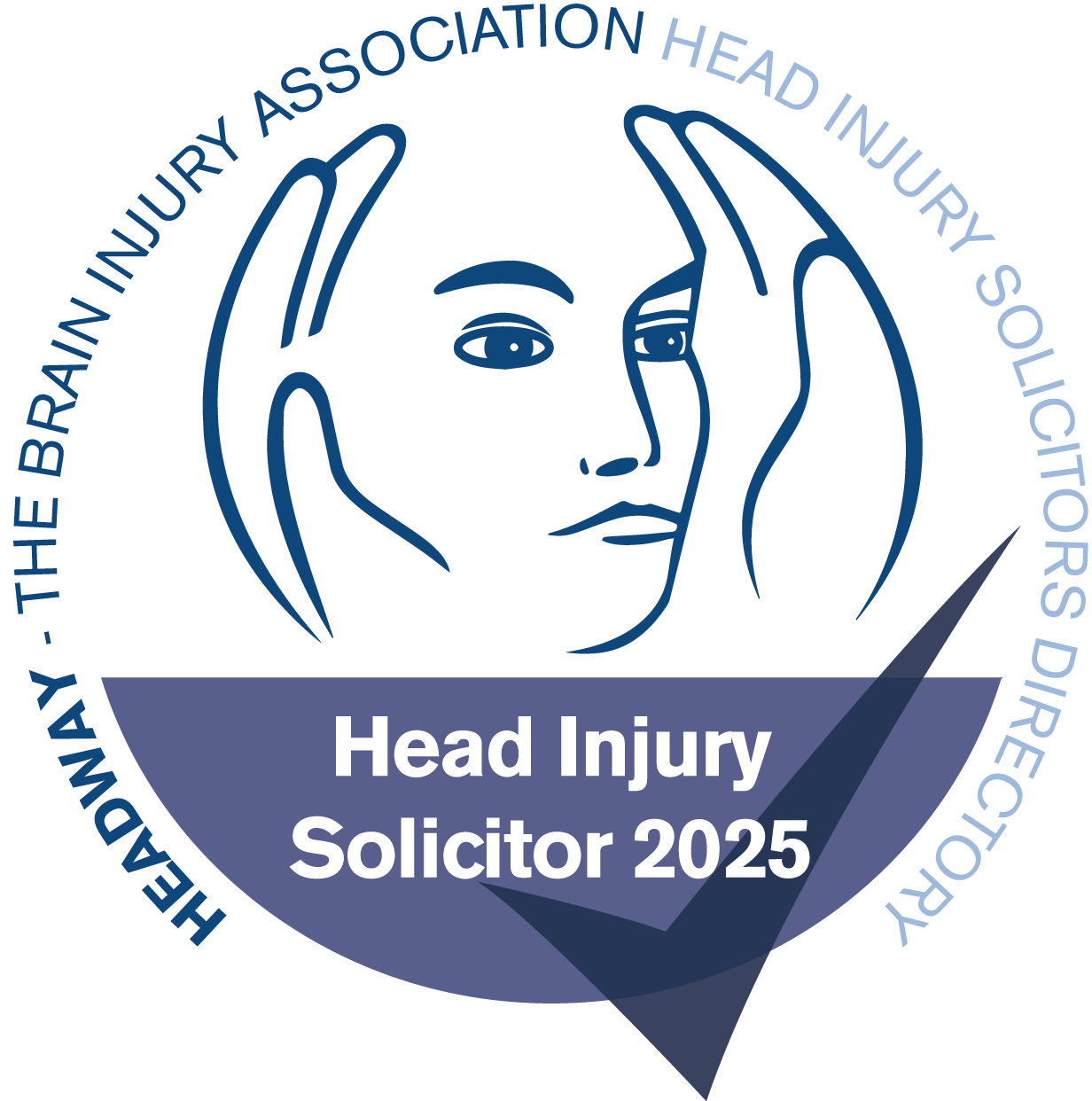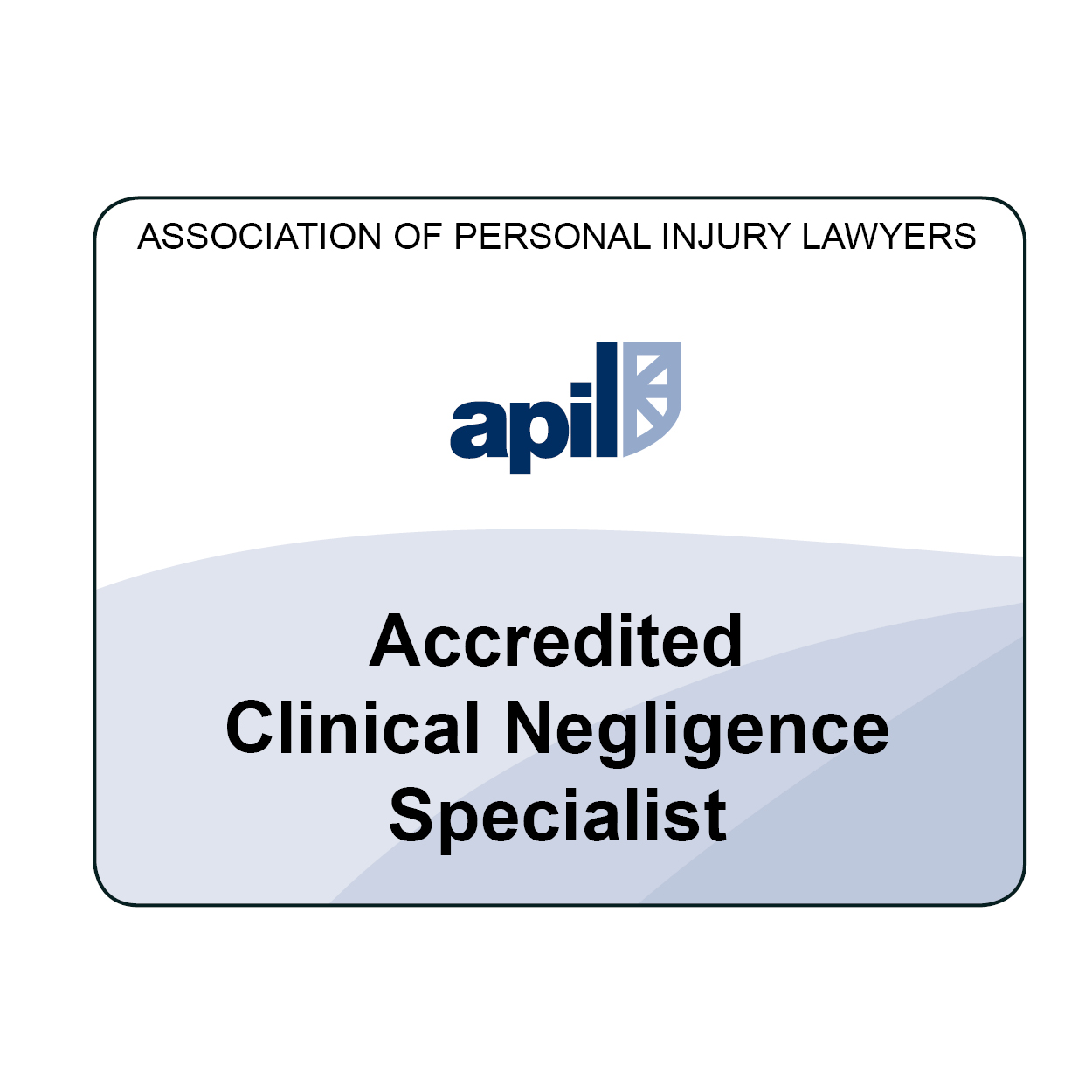Work-related upper limb disorders (WRULDs) are a particular group of musculoskeletal ailments affecting the arm and neck that are the results of work-related activity or an accident at work.
WRULDs affect the arms, from the fingers right up to the shoulder, as well as the neck. They are often referred to as repetitive strain injuries (RSI), cumulative trauma disorder or occupational overuse syndrome.
WRULDs are typically manifested as aches, pains, tension and disorders involving any part of the arm from fingers to shoulder, or the neck. This includes problems with the soft tissues and muscles, tendons and ligaments, as well as circulatory and nerve supply to the limb. Such upper limb disorders are often caused or made worse by work. Therefore, the way work is organised and managed can make a significant contribution to reducing the risk of WRULDs – as well as make them worse.
The True Cost to the UK Economy of Work-Related Upper Limb Disorders
WRULDs can cause a significant amount of pain and discomfort to the victim, loss of productivity for companies and can put a huge financial burden on compensation and healthcare systems. According to the latest figures released by the Health and Safety Executive (HSE), upper limb injuries affected over 233,000 employees in 2014/2015, costing the UK economy approximately 4,112,000 lost working days last year. This equates to 43.44% of all working days lost through work-related musculoskeletal disorders (WRMSDs) in 2014/2015. The economic impact of WRULDs and other workplace accidents on the UK workforce will almost certainly continue to rise as a growing number of people continue to work beyond the traditional age of retirement.
Upper Limb Injury Compensation Calculator
As well as lost working days through upper limb injuries, the UK economy also has to handle the financial strain of compensation claims to victims of arm, elbow, wrist, shoulder and neck injuries as a result of workplace accidents or the working environment itself. Our arm injury compensation calculator, elbow injury compensation calculator, wrist injury compensation calculator, shoulder injury compensation calculator and neck injury compensation calculator pages provide information on the amount of compensation that could be awarded in such cases. A fractured forearm that leaves ongoing symptoms might qualify for compensation of between £4,200 and £12,300, while serious elbow injuries that require surgery or permanently disable the elbow could warrant up to £35,000 in personal injury compensation. To find out how much you could receive for a variety of personal injuries, our compensation calculator pages will provide you with all the information you need.
Overall Work-Related Upper Limb Disorder Statistics
The number of WRULDs in 2013/2014 and 2014/15 were not statistically significantly different, with 203,000 cases of work-related upper limb disorders (650 cases per 100,000 people employed) compared to 233,00 total cases (730 per 100,000 people employed) respectively. The 2014/15 rate is similar to that in 2001/02, which saw a prevalence of 223,000 cases of work-related upper limb injuries (a rate of 780 per 100,000 people employed).
Prevalence Rates for WRULDs by Industry
The industries with the highest prevalence rates of WRULDs were the manufacturing and construction industries, each having a rate of 650 cases per 100,000 people employed over a three-year period: 20011/12, 2013/14 and 2014/15. This is not statistically significantly higher than the rate of upper limb injuries across all industries (530 cases per 100,000). Activities in human health sector (within public administration category) had a prevalence rate of 890 cases – statistically significantly higher than the rate of all industries.
The chart below shows those industries with the highest estimated prevalence rates for WRULDs averaged over the 3 year period 2011/12, 2013/14 and 2014/15:
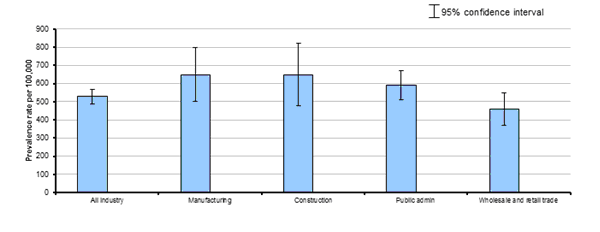
Prevalence Rates for Work-Related Upper Limb Disorders by Occupation
The occupations reporting the highest prevalence rates of WRULDs reflect the industry sectors with the highest rates: skilled building trades; machine operatives and healthcare professions. People who work in these professions are statistically more likely to suffer arm, shoulder and neck injuries than those in other occupations. Work in these sectors generally involves a lot of pulling, lifting and repetitive actions – actions which, when performed incorrectly, can lead to upper limb disorders.
For the three year period 2011/12,2013/14 and 2014/15 the prevalence rate per 100,000 people employed was 530 cases, however, for the skilled building trades this rose to 850 cases; for process plant and machine operatives the rate was 750 cases; and for the health professions the rate was 760 cases. Both the skilled trade professions and process and plant machine operatives had statistically higher rates than the average for all occupations.
The occupations with the highest estimated prevalence rate for WRULDs averaged over the 3 year period 2011/12, 2013/14 and 2014/15 are shown in the chart below:
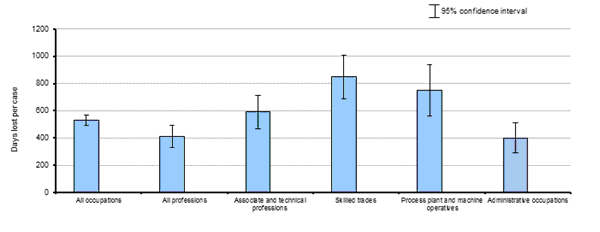
The General Practitioners Scheme and WRULDs
The General Practitioners Scheme, which collects work-related data from patients attending GP clinics, provides some useful information on what the GP and patient believed was the primary cause of upper limb injuries. Examining the published data from 2012-2014, it is obvious that lifting and moving heavy weights; holding tools for extended periods of time; excessive typing and pulling, pushing and carrying materials were the main causes for WRULDs cited by GP’s and their patients during this period.
The chart below gives a breakdown of upper limb disorders reported to THOR-GP according to attributed task THOR-GP, three-year aggregate total 2012 to 2014:
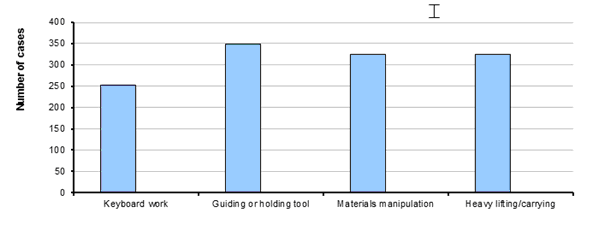
Primary Causes of Work-Related Upper Limb Disorders
Back disorders at work result from exceeding the capability of the muscles, tendons or discs, or are the cumulative effect of several contributors, such as:
- Repetitive work;
- Uncomfortable working postures;
- Sustained or excessive force;
- Carrying out a task for a long period of time;
- Poor working environment and organisation (eg temperature, lighting and work pressure,job demands, work breaks or lack of them); and
- Individual differences and susceptibility (some workers are more affected by certain risks).
The obvious signs and symptoms to look out for include tenderness and pain in the arms, shoulders or neck; stiffness or cramp; a tingling sensation or general swelling in the affected areas. If you are experiencing any of these symptoms and believe the upper limb pain you are suffering is as a direct result of your working environment, please call 0800 083 5500 to find out how we can help.
Blackwater Law have years of experience of helping victims of accidents of work claim compensation for serious workplace accidents and even relatively minor ones such as needlestick injuries. We also have extensive experience of dealing with other types of personal injury claims, such as head and brain injuries, PTSD claims and cosmetic surgery claims. So if you feel you or a family member have suffered an injury that wasn’t your fault, get in touch with us today.



